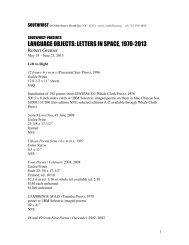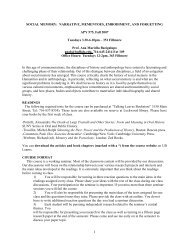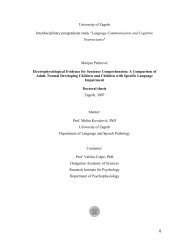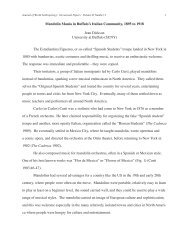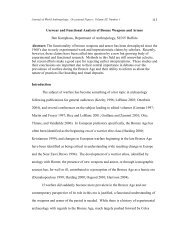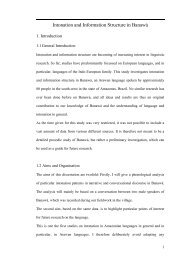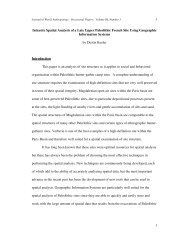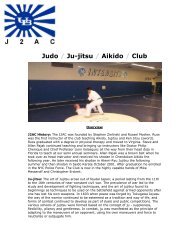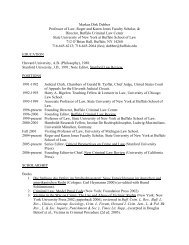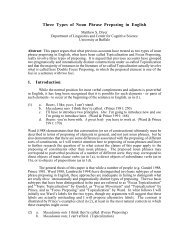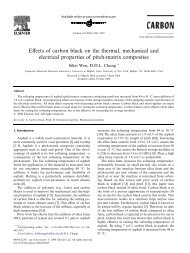left - Wings
left - Wings
left - Wings
Create successful ePaper yourself
Turn your PDF publications into a flip-book with our unique Google optimized e-Paper software.
1. A 60-year old man awakens one morning to find that he has double vision. When he<br />
tries to get out of bed, he notices that he cannot move his <strong>left</strong> arm and leg and his <strong>left</strong><br />
side seems numb. While in the emergency dept. you find the following symptoms:<br />
A. paralysis of the <strong>left</strong> side of the body including the arm and leg.<br />
B. Increased deep tendon reflexes and muscle tone in the arm and leg on the <strong>left</strong>.<br />
C. Babinsky sign in the <strong>left</strong> foot.<br />
D. The right eye is turned medially but the <strong>left</strong> eye is positioned normally.<br />
E. When asked to look to the right side, his <strong>left</strong> eye turns medially but his right<br />
eye does not move.<br />
F. His lower face on the <strong>left</strong> side droops.<br />
G. There is loss of tactile sensation on the <strong>left</strong> side of the body including the arm<br />
and leg. Response to pin prick on the body is normal.<br />
H. There is loss of tactile and pin prick sensation on the <strong>left</strong> side of the face.<br />
2. A 75-year old man awakens one morning and finds he has trouble getting out of bed.<br />
He notices that he cannot move his right arm and leg and his right side seems numb. He<br />
says that his tongue feels thick and doesn't move well. While in the ED you find the<br />
following symptoms:<br />
1. paralysis of the arm, leg and trunk on the right side.<br />
2. Increased deep tendon reflexes and muscle tone in the arm and leg on the right.<br />
3. Babinski sign in the right foot.<br />
4. When asked to protrude his tongue, it deviates to the <strong>left</strong>.<br />
5. Both eyes open and close normally and his smile is normal.<br />
6. There is loss of tactile sensation on the right side of the body, but the face is<br />
normal.<br />
7. Response to pin prick on the right and <strong>left</strong> side of the body is normal.<br />
8. There is loss of pin prick sensation on the right side of the face.<br />
3. A 40 year-old man complained of progressive difficulty using his right hand and a<br />
numb feeling in his <strong>left</strong> hand and leg. On examination, speech was fluent and cranial<br />
nerves were intact. Proprioceptive and tactile sensation were decreased in the right toes,<br />
leg, and fingers. Pinprick sense was decreased on the <strong>left</strong> leg, trunk, and arm. Weakness<br />
was noted in his right leg and hand. Tendon reflexes we increased on the right side and<br />
the Babinski sign was present on the right. (3)<br />
4. A 65-year old man was watching TV when his wife noticed that the right side of his<br />
face drooped. Realizing that he had just had a stoke, she rushed him to the hospital.<br />
While examining him, you find the following symptoms:<br />
1. Paralysis of the arm, leg and trunk on the <strong>left</strong> side.<br />
2. Tendon reflexes in the <strong>left</strong> arm and leg were increased in amplitude and muscle<br />
tone in the <strong>left</strong> arm and leg was increased.<br />
3. Babinski sign was present in the <strong>left</strong> foot.<br />
4. When asked to close his eyes, only the <strong>left</strong> eye closed.<br />
5. When asked to smile, the mouth on the <strong>left</strong> side turned upward normally, but on<br />
the right side the corner of the mouth drooped downward.
6. When asked to wrinkle his forehead, the <strong>left</strong> side wrinkled but the right side<br />
remained smooth.<br />
7. Tactile sensation on the right and <strong>left</strong> side of the body and face was normal.<br />
8. He did not feel pinprick on the <strong>left</strong> side of the body, but the right side was<br />
normal.<br />
5. A 29 year-old woman suddenly experienced double vision and weakness of her <strong>left</strong><br />
upper and lower limbs. Neurological examination showed weakness of her <strong>left</strong> arm and<br />
leg accompanied by increased resistance to passive stretch, increased tendon reflexes,<br />
and the Babinski sign in her <strong>left</strong> foot. In addition, she had loss of tactile sensation and<br />
limb position sense on the <strong>left</strong> side in the leg, trunk, arm, and neck. Pin prick sensation<br />
was normal on the body, but absent on the <strong>left</strong> side of the face. Both eyes converged<br />
when she visually followed a probe as it was brought close to her nose. However, her<br />
right eye was deviated medially. When she attempted to gaze to the right, her <strong>left</strong> eye<br />
moved to the right but her right eye did not move.<br />
6. An 80-year-old man collapsed suddenly while he was in the shower. He was taken to<br />
the hospital and regained consciousness after 2 days. A neurological exam showed<br />
paralysis of the right upper limb with hyperactive reflexes and increased muscle tone.<br />
The right arm was held in a flexed posture with the elbow and wrist bent. The right<br />
corner of his mouth drooped, but he could close and open both eyes equally on each<br />
side. There was loss of tactile sensation on the right upper limb and right side of the<br />
face and he could not distinguish the position of his right arm when it was moved<br />
passively. Pin prick was felt, but poorly localized in the right limb and right face. He<br />
also had a right lower homonymous quadrantanopsia.<br />
7. A 60-year-old woman awoke one morning feeling dizzy with nausea, vomiting and<br />
unsteady gait. She was brought to the emergency room where a neurological exam<br />
revealed the following findings. Nystagmus was present bilaterally. Both pupils reacted<br />
normally to light, but the right pupil was smaller than the <strong>left</strong>, there was mild ptosis of<br />
the right eyelid, and the right side of the face appeared flushed. Eye movements were<br />
normal, as was her ability to close her eyes and her ability to smile. When a cotton<br />
swab was placed on the <strong>left</strong> side of her throat, there was a gag response, but when the<br />
right side was touched there was no response. Sensation to pin prick was absent on the<br />
right side of the face and also the <strong>left</strong> side of the neck, trunk and limbs. Tactile<br />
sensation and awareness of limb position were normal on both sides of the body and<br />
face. However, she could not stand without falling. Upper and lower limb reflexes were<br />
normal, strength was normal, and the plantar reflexes were flexor. The finger-to-nose<br />
test revealed a prominent tremor during movement and inaccuracy in movement in the<br />
right upper limb as the finger approached the nose, but the test was normal in the <strong>left</strong><br />
upper limb. Rapid, alternating movements of the right hand were clumsy, but normal in<br />
the <strong>left</strong> hand. The heel-to-shin test indicated an inability to move the right leg smoothly<br />
or accurately, but the <strong>left</strong> leg was normal.
8. A 22-year-old man is brought to the emergency room after being shot outside his home<br />
during an argument with a neighbor. On examination you find the patient is alert,<br />
attentive, and responsive to questions indicating normal mental status. Cranial nerve<br />
function is also normal. However, there is paralysis of the <strong>left</strong> trunk and lower limb<br />
with increased muscle tone, increased deep tendon reflexes and Babinski sign. Muscle<br />
strength, deep tendon reflexes, and plantar reflex are normal on the right side.<br />
Sensation to pin prick is absent on the right side from the level of the nipple down, but<br />
normal on the <strong>left</strong>. Tactile sensation and position sense are normal on both sides.



